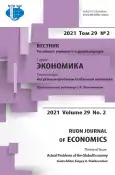Analysis of currency integration indicators in the Eurasian Economic Union
- 作者: Budarina N.A.1, Chernenkov A.S.1
-
隶属关系:
- Russian Customs Academy
- 期: 卷 29, 编号 2 (2021): ACTUAL PROBLEMS OF THE GLOBAL ECONOMY
- 页面: 402-412
- 栏目: Economic integration and globalization
- URL: https://journal-vniispk.ru/2313-2329/article/view/324228
- DOI: https://doi.org/10.22363/2313-2329-2021-29-2-402-412
- ID: 324228
如何引用文章
全文:
详细
For the world economy, the integration process is one of the most widespread and global. The Eurasian Economic Union is a typical example of bringing countries together to achieve shared goals and to face diverse challenges successfully by implementing coordinated policies and harmonizing the regulatory framework. The formation of a monetary union will be the next stage of integration. The EAEU member States need to achieve a certain level of economic convergence for that purpose. Thus, the main aim of this research article is to analyze some of the economic indicators of the EAEU in order to identify common problems, the solution of which will be necessary for the successful formation and functioning of the monetary union. The authors have studied such indicators as GDP volumes and inflation levels, as well as the dynamics of changes in exchange rates and the level of mutual direct investment in terms of sigma convergence. The authors have also used methods of graphical representation of the scientific results. The reports of the Eurasian Economic Commission and the Central Banks of the EAEU Member States were used as the main sources of statistical data.
作者简介
Natalya Budarina
Russian Customs Academy
编辑信件的主要联系方式.
Email: n.budarina@customs-academy.ru
Doctor of Economic Sciences, Professor, Chair of International Economic Relations, Faculty of Economics
4 Komsomolskii Prospekt, Lyubertsy, 140015, Russian FederationArtem Chernenkov
Russian Customs Academy
Email: artyomchernenkov@gmail.ru
PhD student, Chair of International Economic Relations, Faculty of Economics
4 Komsomolskii Prospekt, Lyubertsy, 140015, Russian Federation参考
- Drobyshevskij, S.M., & Polevoj, D.I. (2004). Problems of creating a single currency zone in the CIS countries. Moscow, Gaidar Institute for Economic Policy. (In Russ.)
- Ishiyama, Y. (1975). The theory of optimum currency areas: A survey. IMF Staff Papers, 42(2), 344-383. http://dx.doi.org/10.1177/0974929216631381
- Ishkhanov, A.V., & Linkevich, E.F. (2016). On the tax policy of the EAEU countries in the conditions of the formation of a monetary union. Finansovye Issledovanija, 4(53), 101-107. (In Russ.)
- Kenen, P. (1980). The theory of optimum currency areas: An eclectic view. Essays in International Economics (pp. 163-182). http://dx.doi.org/10.2307/j.ctvbcd28k.14
- Krasavina, L.N. (2017). On increasing the role of currency factors in the formation of sustainable competitive advantages of the EAEU countries. Russian Journal of Money and Finance, (14), 14-20. (In Russ.)
- Kuzmina, E.M. (2017). Economic development of EAEU countries and prospects of economic integration till 2025 (pp. 8-18). Moscow. (In Russ.)
- McKinnon, R.I. (2004). Optimum currency areas and key currencies: Mundell I versus Mundell II. Journal of Common Market Studies, 42(4), 689-715. http://dx.doi.org/10.1007/ 978-3-322-82092-1_1
- Melnikov, A.B., Markevich, Yu.A., & Falina, N.V. (2020). State and level of development of integration processes in the EAEU as components of economic security of integration association. RUDN Journal of Economics, 28(1), 55-71. https://doi.org/10.22363/2313-23292020-28-1-55-71
- Misko, O.N. (2015). International economic integration. Saint Petersburg, ITMO University. (In Russ.) Mundell, R.A. (1961). A theory of optimum currency areas. The American Economic Review, 51(4), 657-665.
- Robson, P. (1987). The economics of international integration. London, Allen and Unwin. http://dx.doi.org/10.1007/978-1-349-20923-1_6
- Voronina, T.V., & Babaeva, E.E. (2015). Theoretical concepts of currency unions and the practice of their implementation in the Euro area]. Problems of Territory's Development, 6(80), 186-200. (In Russ.)
补充文件









